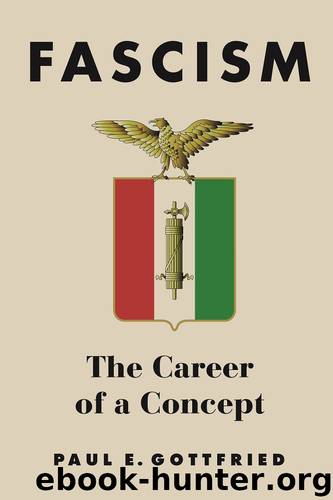Fascism: The Career of a Concept by Paul Gottfried

Author:Paul Gottfried [Gottfried, Paul]
Language: eng
Format: epub
Tags: Fascism
Publisher: Northern Illinois University Press
Published: 2016-02-08T05:00:00+00:00
Anti-New Deal Journalists and Fascist Collectivism
Attacks on fascism as a collectivist threat to American freedom began in the 1930s, as proponents and critics of the New Deal assailed each other in print. Before the mid-1930s Italian fascism appealed strongly to American socialists as much as it did to Catholics, who commended Mussolini for the Lateran Pacts. Well into the 1930s, despite the adversarial press erected by Mussolini’s predominantly leftist opposition in exile mostly in Paris, the Italian fascist government enjoyed some appeal across the American political spectrum. The lyric from the Cole Porter musical “Anything Goes," as rewritten for the London production by P. G. Wodehouse in 1935, celebrates Mussolini as the ‘top’ This reference was dropped in later productions but suggests the enthusiasm once felt in the English-speaking world for a man “who made the trains run on time” in a longtime chaotic country.
The New Republic abounded with tips for how America might learn from the Italian experiment, and such socialist reformers as Horace Kallen, George Soule, and Stuart Chase rushed to recommend the fascist notion of autarchy and having the state protect corporate structures in a way that would benefit the working class. Although some New Dealers like Rexford Tugwell saw features of Soviet Russia that likewise attracted them, fascism seemed to offer a promising halfway point between bolshevism and capitalism.
According to New Deal critic John T. Flynn, an apparent moderateness rendered the Italian model even more insidious: “A man could support publicly and with vehemence this system of the Planned Economy without incurring the odium of being too much of a radical for polite and practical society” 18 In addition, Mussolini and, later, even more decisively, Hitler put the nails in the coffin of the true liberal tradition by constructing the “Planned Capitalist State.” The “direct opposite of liberalism,” fascism was “an attempt, somewhere between Communism and capitalism, to organize a stable society and to do it by setting up a state equipped with massive powers over the lives and fortunes of the citizens” 19
Flynn’s observations, which libertarian publicists of his acquaintance shared, would have made it hard for him and others of his persuasion to treat fascism as a strictly leftist movement: “This may be a wise dispensation, but it is the negation of liberal philosophy which for decades has been fighting to emancipate the people from the tyranny of all-powerful states” A preference for liberty over any kind of order, including traditional order, characterizes the minimal government rhetoric of American libertarians in the 1930s and 1940s, and it can be discovered in such representative works as Friedrich von Hayek’s Road to Serfdom (1944) and Flynn’s As We Go Marching (1945). 20 Here one finds articulated the thoughts of anti-collectivists who were at war with America’s emerging welfare state. The ideological dividing line for them was not between a traditional Right and a traditional Left or between a revolutionary Right and a revolutionary Left but between collectivist and individualist conceptions of society. 21
Libertarians Flynn, Albert J. Nock, Garet Garrett, and
Download
This site does not store any files on its server. We only index and link to content provided by other sites. Please contact the content providers to delete copyright contents if any and email us, we'll remove relevant links or contents immediately.
| Anarchism | Communism & Socialism |
| Conservatism & Liberalism | Democracy |
| Fascism | Libertarianism |
| Nationalism | Radicalism |
| Utopian |
The Secret History by Donna Tartt(18186)
The Social Justice Warrior Handbook by Lisa De Pasquale(11957)
Thirteen Reasons Why by Jay Asher(8461)
This Is How You Lose Her by Junot Diaz(6451)
Weapons of Math Destruction by Cathy O'Neil(5841)
Zero to One by Peter Thiel(5498)
Beartown by Fredrik Backman(5369)
The Myth of the Strong Leader by Archie Brown(5243)
The Fire Next Time by James Baldwin(5024)
How Democracies Die by Steven Levitsky & Daniel Ziblatt(4966)
Promise Me, Dad by Joe Biden(4911)
Stone's Rules by Roger Stone(4866)
100 Deadly Skills by Clint Emerson(4695)
A Higher Loyalty: Truth, Lies, and Leadership by James Comey(4555)
Rise and Kill First by Ronen Bergman(4548)
Secrecy World by Jake Bernstein(4393)
The David Icke Guide to the Global Conspiracy (and how to end it) by David Icke(4386)
The Farm by Tom Rob Smith(4329)
The Doomsday Machine by Daniel Ellsberg(4250)
